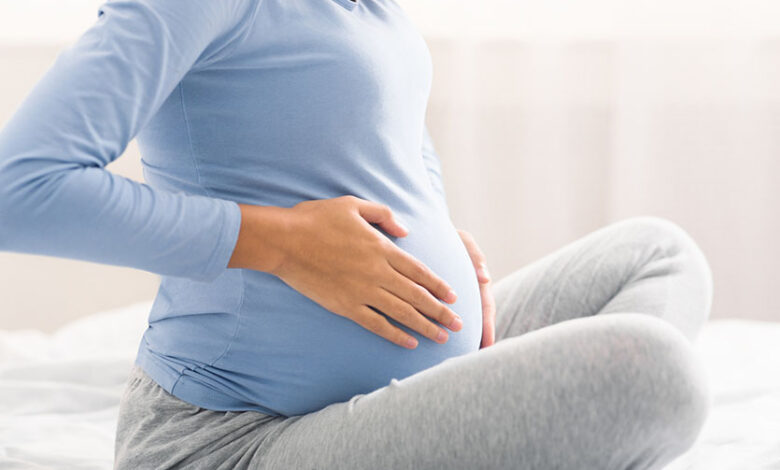Making the most of your second trimester

The second trimester of your pregnancy is an exciting time! During weeks 14–27, you will typically begin to feel better and start showing your pregnancy more. As your body changes and your baby continues to grow, there are many different things you can do to make this stage a healthy and happy one for both you and your little one.
How can you care for yourself during your second trimester?
Exercise
Taking the time to get your body moving is important to your overall well-being. Activities such as brisk walking, easy jogging, low-impact aerobics, water aerobics and yoga are good choices. Try to do at least 2½ hours a week of moderate exercise, such as a fast walk. One way to do this is to be active 30 minutes a day, at least five days a week. Don’t forget to include a warm up and cool down, and use light weights, if strength training, to help reduce stress on your joints.
If you did not exercise much before pregnancy, start slowly. For many people, walking is a good way to begin. Pace yourself and do a little more every day.
Reduce stress
For some women, pregnancy can be an overwhelming time, so it’s critical that you take steps to reduce stress as much as you can. That may include asking for help with cooking and housekeeping, learning relaxation techniques at a prenatal or yoga class, or taking the time to walk, listen to music or try breathing exercises every day. To start, try relaxing for just 10 to 15 minutes at a time. Taking small breaks like this can make a big difference.
If worrying or anxiety gets in the way of your daily life, talk to your healthcare provider about additional steps you can take to help.
Sleep better
With the aches, pains and stress that often come with pregnancy, getting quality sleep can be a challenge. Because you and your baby benefit immensely from a good night’s rest, it’s necessary to try and get as much shut eye as you can. To help, you can avoid caffeine in drinks and chocolate late in the day, take a warm shower or bath before bed, or do relaxation exercises in bed to calm your mind and body.
For a more comfortable sleep, try supporting your legs and back with extra pillows or putting a pillow between your legs if you sleep on your side.
Ease leg cramps
Leg cramps are common in pregnancy, occurring most often during the night in the second and third trimesters. Although painful, there are some things you can do to prevent these muscle spasms from happening, including these simple exercises:
- While sitting on a firm bed or chair, straighten your leg and bend your foot slowly upward, toward your knee. Bend your toes up and down.
- While standing on a flat surface, stretch your toes upward. For balance, hold on to the wall or something stable. If it feels okay, take small steps, walking on your heels.
If you do experience leg cramps, you can use a heating pad or hot water bottle to help with muscle aches.
Reduce swelling
It’s normal to experience some swelling during pregnancy, especially in your ankles, feet, hands and fingers. To reduce swelling, you should avoid high-sodium foods such as potato chips, take off your rings if your fingers are puffy, not stand for long periods of time and make sure your shoes aren’t too tight. You may also find relief from propping your feet up on a stool or couch as much as possible and sleeping with pillows under your feet to take some of the pressure off.
Support stockings or compression socks can also be worn to help improve circulation, reenergize your feet and legs, and minimize swelling.
When should I call my doctor?
It’s common to have concerns when you’re pregnant. Even though most concerns are not serious, it’s important to know when to call your doctor or midwife. Here are some general guidelines.
Seek medical care right away if you’re experiencing:
- Vaginal bleeding
- Fever
- Belly pain
- Dizziness, lightheadedness or feeling faint
- Signs of a blood clot in your leg (called a deep vein thrombosis), such as:
- Pain in the calf, back of the knee, thigh or groin
- Swelling in your leg or groin
- A color change on the leg or groin, with skin that’s reddish or purplish depending on your usual skin color
- Symptoms of preeclampsia, such as:
- Sudden swelling of your face, hands or feet
- New vision problems (dimness, blurring or seeing spots)
- A severe headache
- Symptoms of a bladder infection, like:
- Pain or burning when you urinate, or blood in your urine
- A frequent need to urinate
- Pain in your lower back (below the rib cage and above the waist)
- Urine that has a bad odor
- Less movement or stopped movement of your baby
- Regular contractions for an hour (at least six contractions within one hour, even after you change positions and drink fluids)
- A sudden release of fluid from your vagina (your water breaking)
Watch closely for changes in your health, and be sure to contact your doctor if:
- You have vaginal discharge that smells bad
- You feel sad, anxious or hopeless for more than a few days
- You have skin changes, such as a rash, itching or a yellow color to your skin
- You have other concerns about your pregnancy
Make the most of your second trimester by trying some of these tips for a safe, healthy pregnancy. Visit us online for additional prenatal resources, including classes, events and services/care offered at Parkview.
Copyrighted material adapted with permission from Healthwise, Incorporated. This information does not replace the advice of a doctor.
